Kawasaki’s Ninja 1000 has always been one of our favorite bikes. Sportbike handling and power combined with sport tourer comfort and practicality. Kawasaki U.S. has announced the updated 2017 version with a number of new features. You can read all the details below, but there are plenty of ergonomic improvements, new instrument panel and sophisticated electronic aids courtesy of a Bosch six-axis IMU.
The 2017 Ninja 1000 ABS will be in dealers next March priced at $12,199. Follow this link for further details and specifications, and here is Kawasaki’s press release:
The roar of a pack of superbikes echoes through the rolling hills of Northern California. The world famous Laguna Seca Race Track is alive with another race weekend. The lead group climbs the backstretch headed for the corkscrew. Atop the adjacent hill is a lone sportbike parked overlooking, watching as the laps tick away with lightening speed. The checkered flag waves signaling the end of the race, but the beginning of your adventure.
The kickstand snaps up, as you roll onto a two-lane twisty road. You head west, towards the coast. You’re many miles from home, but you still decide to take the long way back. You’re a racer at heart, but you’re not on the track—at least not today—instead, you’re riding many miles to watch the race up close. Now, it’s time for you to have your fun.
Introducing the 2017 Ninja® 1000 ABS, infused with Ninja sportbike spirit, speed-minded technology and engineering, but with the comfort of a touring motorcycle.
The 2017 Kawasaki Ninja 1000 ABS motorcycle:
- NEW enhanced chassis orientation awareness technology featuring Bosch IMU
- NEW Kawasaki Cornering Management Function
- NEW Kawasaki Intelligent Anti-Lock Brake System (KIBS)
- NEW Windshield and fairings
- NEW Lower more ergonomically comfortable seat
- NEW ECU tuning
Kawasaki’s flagship, open-class sport touring bike with power and comfort, the Ninja 1000 ABS returns for 2017 with added electronics, normally reserved for race models. Built for riders wanting sporty handling and smooth, powerful acceleration, the Ninja 1000 ABS has all of that, but in a relaxed, comfortable riding position—creating a motorcycle with liter-bike performance, but a level of comfort and versatility that allows the miles to roll on with ease. Now, with the added electronics, the 2017 Ninja 1000 ABS will give riders increased confidence on their next ride.
New for 2017 are wider fairings, a new double-bubble windscreen, 5-way adjustable clutch lever and seat, all aiding in increased rider comfort, making the 2017 Ninja 1000 even more enjoyable. Hard, KQR™ color-matched saddle bags may be selected from among a variety of Kawasaki Genuine Accessories, further enhancing the touring comfort of the Ninja 1000 ABS.
ELECTRONICS
- New A Bosch IMU with 6-axis of measurements
- New Kawasaki Cornering Management Function
- New Kawasaki Intelligent anti-lock Brake System (KIBS)
- Kawasaki Traction Control (KTRC)
- Power mode selection
Utilizing technology previously reserved for the Ninja® ZX™-10R sportbike, the 2017 Ninja 1000 ABS motorcycle features a 6-axis Bosch Inertial Measurement Unit (IMU) that includes electronic rider aids such as: Kawasaki Cornering Management Function, Kawasaki TRaction Control (KTRC) , and Kawasaki Intelligent anti-lock Brake System (KIBS).
The system uses minimal hardware but complex Kawasaki proprietary software. The strength of Kawasaki’s cutting-edge electronics has always been the highly sophisticated programming that gives the ECU an accurate real-time picture of what the chassis is doing. Kawasaki’s proprietary dynamic modeling program makes skillful use of its formula as it examines changes in multiple parameters, enabling it to take into account changing road and tire conditions.
The new Bosch IMU enables inertia along five DOF (degrees of freedom) to be monitored: acceleration along longitudinal, transverse and vertical axes, plus roll rate and pitch rate. While the sixth axis, yaw rate, is calculated by the ECU using Kawasaki original software. Bosch’s latest IMU is compact and very lightweight, weighing only 40 g.
Using the latest evolution of this advanced modeling software, KCMF monitors engine and chassis parameters throughout the corner – from entry, through the apex, to corner exit – modulating brake force and engine power to facilitate smooth transition from acceleration to braking and back again, and to assist riders in tracing their intended line through the corner.
Three modes cover a wide range of riding conditions, offering either enhanced sport riding performance or the peace of mind to negotiate slippery surfaces with confidence. Modes 1 and 2 prioritize maximum forward acceleration, while Mode 3 provides rider reassurance by facilitating smooth riding on slippery surfaces. Riders may also elect to turn the system off.
In Modes 1 and 2, highly sophisticated programming allows a degree of slip – a certain amount of slip is required to maximize acceleration. The ideal slip ratio varies according to conditions. The system looks at a number of parameters to get an accurate real-time picture of what is going on: front and rear wheel speed (slippage) and various engine, machine and rider input parameters are monitored. The IMU-enhanced feedback allows even more precise management than on the previous model.
KIBS AND BRAKING
KIBS is a multi-sensing system, using the input from numerous sources, to provide the best braking possible. In addition to front and rear wheel speed sensors (standard for any ABS system), KIBS also monitors front caliper hydraulic pressure and various information from the engine ECU (throttle position, engine speed, clutch actuation and gear position). High-precision brake pressure control enables the system to avoid reduced brake performance due to excessive pressure drops, allows lever feel to be maintained when KIBS is active, and helps ABS pulses feel smoother (not heavy).
High-precision brake pressure control also offers a number of sport riding benefits: less rear lift under hard braking, minimal kickback during operation and accounting for back-torque. With the addition of the new KIBS systems comes improved rear brake pad material and optimized spring.
ERGONOMICS
- NEW Wider fairings and taller double-bubble windshield
- NEW 5-way adjustable clutch lever
- NEW Mirrors for increased visibility
- NEW Lower, wider and comfortable seat for rider and passenger
The relatively upright position—compared to supersport models—offers both control and comfort for riders. Separate, raised clip-ons are mounted on top of the forks, for relaxed arm position, while maintaining a sporty and comfortable riding position.
A new 5-way adjustable clutch lever can be set to suit the size of the rider’s hands, aiding in rider comfort. Mirrors are positioned 20mm farther outward and have a greater range of movement, offering easier adjustability.
Both rider and passenger seats deliver increased comfort. The redesigned rider seat has a wider seat area, offering greater support, and enabling longer stretches without having to stop due to discomfort.
The passenger seat is longer with thicker urethane padding and a design that swells at the front, resulting in a larger seat area that keeps passengers from sliding forward. Dampers on the underside of the seat also help reduce vibration. Ergonomically sculpted passenger grips are easy to hold and naturally positioned, contributing to even more passenger comfort.
The fairing design also covers part of the frame, contributing to a good ergonomic fit and helping to protect the rider from engine heat for added comfort.
STYLING
- NEW Headlight design for a sporty look and increased visibility
Supersport-style full-fairing bodywork gives the Ninja 1000 ABS motorcycle a distinct, head-turning look. The sleek styling also offers a good measure of wind protection, aiding to reduce rider fatigue. Front cowl design is much sharper, giving the 2017 Ninja 1000 ABS a much sportier appearance and greatly increasing its Ninja family resemblance. Chin spoilers similar to those on the Ninja H2™ and Ninja ZX-10R motorcycles strengthen the resemblance.
Turn signals are built into to the fairings to aid in the slim profile and sporty look. Supersport-style front fender contributes to both aerodynamics and racy looks.
ENGINE
- Exhilarating power from the 1000cc, inline 4-cylinder engine
- New ECU settings for smoother power delivery and functionality with the Kawasaki Corner Management
Powerful 1,043cm3 liquid-cooled, 4-stroke in-line four-cylinder engine pulls strongly from all rpm. Adding to rider exhilaration, the engine delivers superb engine response, a strong mid-range hit and an intoxicating intake howl. Revised engine settings offer even smoother power delivery, facilitating control and contributing to rider comfort and confidence.
Downdraft throttle bodies allow for the shortest path to the engine, helping for ideal low-mid range power. The throttle bodies are oval sub-throttles allowing for a slim profile of the engine as well.
The Ninja 1000 ABS features many enhancements that allow for a smoother engine feeling and less vibration to the rider. One major feature is the secondary balancer on the engine crankshaft, which eliminates excessive vibration.
CHASSIS
- Highly rigid aluminum frame
- Combination of solid and rubber engine mounts for reduced vibration and excellent handling characteristics
Thanks to a rigid, lightweight aluminum frame and compact engine design, the weight is not only low and centered inside the motorcycle, but the overall profile is also slim. This centralization allows for sharp handling, neutral steering and a light turn-in. Lightweight and highly rigid, the frame uses the engine as a stressed member.
The frame is a 5-piece cast aluminum construction, consisting of steering stem, left and right main frames, and two cross pieces. The front part of the rear frame is an example of form and function combined, allowing the side covers to be eliminated. This also allows the width under the seat to be narrower, offering riders a shorter reach to the ground.
SUSPENSION
- 41mm front inverted forks
- Front and rear adjustability
Up front you’ll find 41mm inverted front forks with stepless compression and rebound damping and spring preload adjustability. Settings offer both sporty performance (contributing to light handling on the street and in the hills) and comfort.
Rear suspension positions the shock unit and linkage above the swingarm, allowing for greater mass centralization. The rear shock features rebound and preload adjustability, with a remote preload adjuster facilitating setting changes to suit tandem riding, luggage or rider preference. This is ideal for quick, on-the-go adjustability when traveling.
INSTRUMENTATION
- NEW Instrument panel
- NEW LCD screen
- NEW Gear position indicator
- NEW Shift light
An all-new instrument panel layout features a large analogue tachometer flanked by warning lamps on one side, and a gear position indicator and multi-function LCD screen on the other. The LCD screen features a negative-lit display, adding to the instrument cluster’s sporty, modern appearance. Gear position indicator increases shifting precision and confidence, while also lending to the Ninja 1000 ABS’s sporty image.
Complementing the gear indicator is a new shift light, the tachometer’s needle changes color (from white to pink to red) to indicate the rider-selectable shift-up timing. During normal operation the shift indicator lamp is off, and the tachometer needle is white. When engine speed is within 500 rpm of the selected shift-up timing, the shift indicator lamp flashes, and the tachometer needle turns pink. When the pre-chosen rpm is reached, the shift indicator lamp flashes rapidly, and the tachometer needle turns red. Riders can set the shift-up timing between 5,000 and 11,000 rpm in 250 rpm increments. The shift indicator function can also be turned off completely.
In addition to the digital speedometer and gear position indicator, display functions include: odometer, dual trip meters, remaining fuel range, current and average fuel consumption, external temperature (new for 2017), coolant temperature, clock and the Economical Riding Indicator.
Colors:
Candy Lime Green / Metallic Graphite Gray
Metallic Spark Black / Metallic Graphite Gray
MSRP:
2017 Kawasaki Ninja 1000 – $12,199
Availability:
The 2017 Ninja 1000 ABS motorcycle will be in dealerships starting March, 2017. Check with your local dealership for availability.
For a full spec sheet on the 2017 Ninja 1000 ABS, www.kawasaki.com.
ACCESSORIES
A feature that sets the Ninja 1000 ABS apart is the large number of Kawasaki Genuine Accessories for owners to choose from, allowing them to create the unique sport tourer, just for them – like the hard Kawasaki Quick-Release color-matched side bags. .
A full range of Kawasaki Genuine Accessories are available at authorized Kawasaki dealers. For the different models, these can include different seats, seat cowl, frame sliders, tank bag and tail bag. Please visit your local Kawasaki dealership for more information.
See more of MD’s great photography:
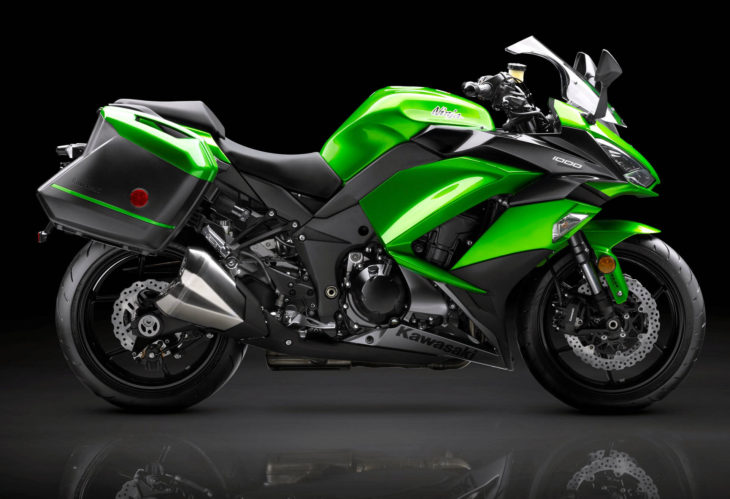
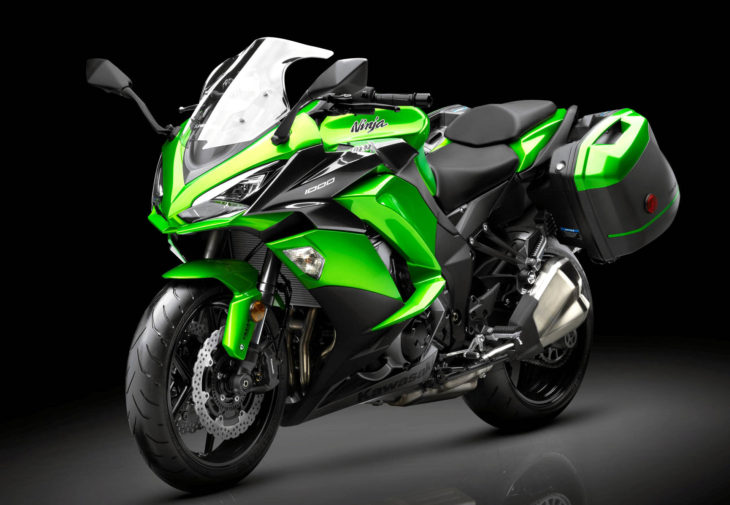
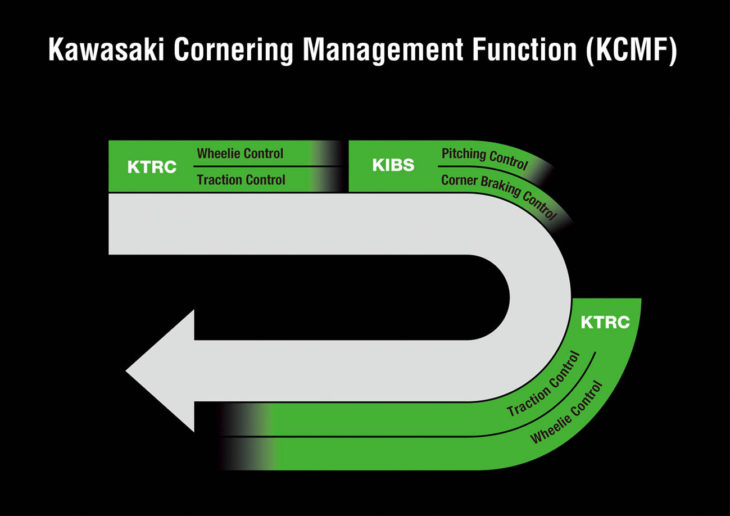
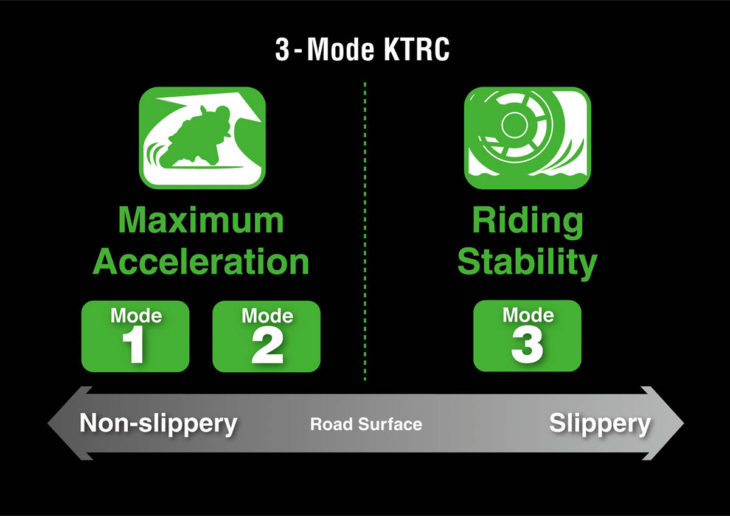
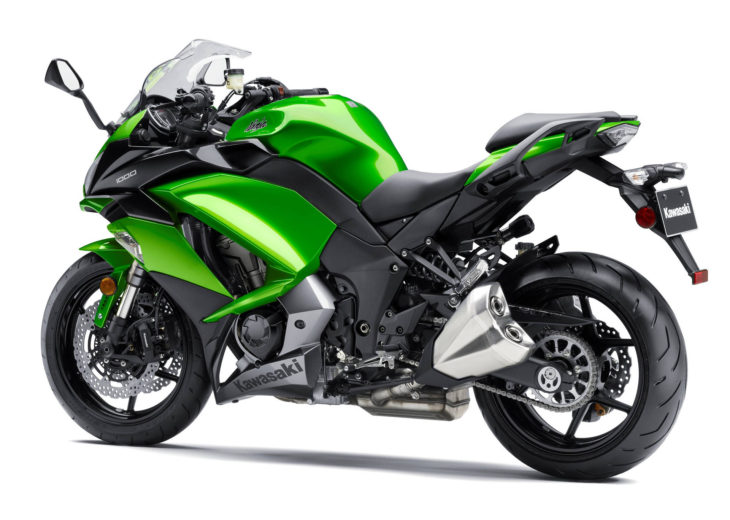

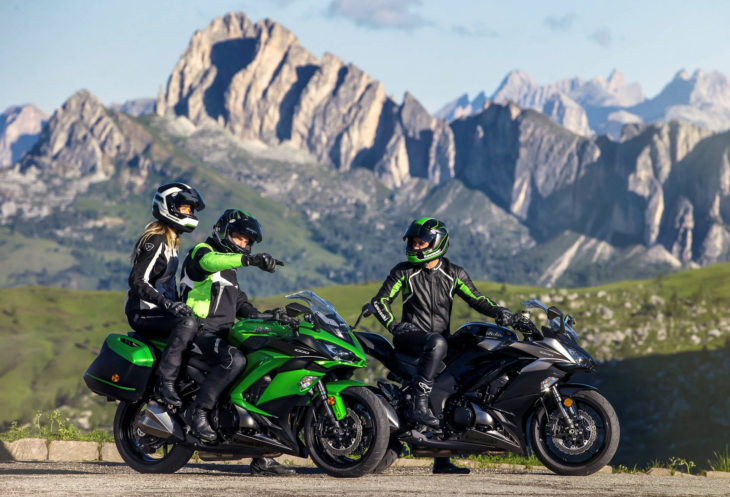
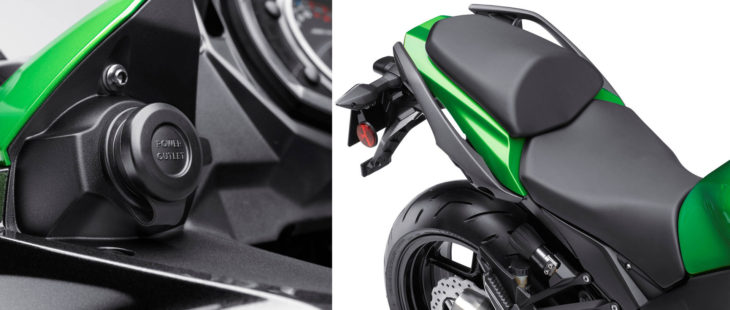
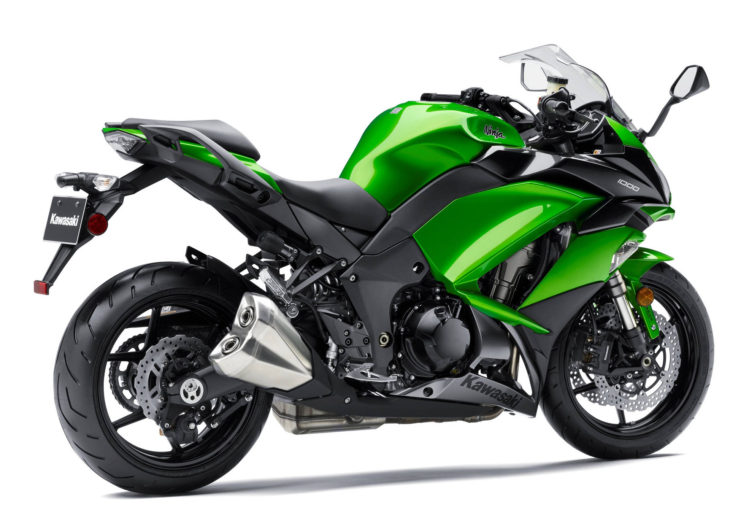






Impressive electronics update…now where is the cruise control?
I just picked up a 2016 without the bags for 9K, a great value. The low gearing is easily fixed with a sprocket change and it’s not hard to shed 30 pounds off this bike.
Still heavy and lower tech than the actual Ninja RR but a nice ride nonetheless. I do wish they would offer more color options though. The extreme green and dull grey just don’t do it for me.
Why didn’t they do these electronic updates to the versys 1000? I’d like to see that.
They should have picked a model under 6′ tall to pose on that passenger seat. That seating position looks really dumb.
So it looks like they didn’t do anything about the bike’s fatal flaw, a short 6th gear. Nice work Kawasaki!
They addressed that issue with the changes to the 2014 model.
Ride one, it’s still an issue.
Might be how its so competitive against the Supersports in those top gear roll on tests they like to boast about.
All that digital tech and no cruise control. That’s utterly stupid.
“Ninja” isn’t cool anymore? Dang! In 1985 “Ninja” was badass. But then those darn turtles hijacked the name and it became silly. I guess the memo never made it across the pond.
Doesn’t the passenger above look comfortable? That little peaked pillion seat has to be real cozy feeling.
I’ve seen these go with bags for $12 K OTD. That leaves you a little money left to add the brake lines and pipes. Then all you have to do is live with the childish name and winking headlight.
Pretty much +1 on all of the above. Of course, I’m so anti-manga styling I bought a Sportster. With Progressive Suspension at both ends and some premium tires it corners well enough to keep this old man happy.
If Kawasaki is going for the ugliest motorcycle on Earth prize, they’ve succeeded.
I quick perusal of the suzuki catalog may change your mind. They may even hold a patent.
Nearly everyone hates the pipes, and they’re still silly, but at least they’re not as monstrously enormous as some we’ve seen recently. They’re needlessly goofy, but not completely horrible.
Not a deal-breaker.
Nearly everyone hates the ‘Ninja 1000’ name, as it’s not just stupid for a bike that will mostly appeal to people on the far side of forty, it’s downright expensive. Most middle-aged white guys don’t want to be seen on something called a ‘Ninja,’ and insurance companies really don’t like Ninjas.
Probably not a deal-breaker, but close.
Nearly everyone hates a lack of choices when it comes to colors on a sporty sport-tourer. For many, Kawi Green is a nonstarter. Just not going to do it. Many others are entirely sick of gray, black, black-gray, matte gray, matte black, etc. Black-gray is fine as a mature, alternate choice, but it can’t be the only option besides Neon Green.
Possibly a deal-breaker, particularly for those who won’t accept a bike that looks like and is even named after the Teenage Mutant Ninja Turtles.
Nearly everyone hates the recent trend of only one of the two headlights lighting up on low-beam. This was never a good idea. It will never be a good idea. This isn’t brain surgery, either. Two headlights = good. Both headlights lighting up on low-beam and high-beam = no-brainer.
Not a deal-breaker, but very annoying, and there’s no reason for it. Add up enough of these small annoyances and you may be approaching deal-breaker status.
Nearly everyone hates having to pony up an extra grand for factory hardbags that obviously should be included as standard. Most bikes that offer bags as well designed and purpose-built for a specific model as these bags clearly are include the bags as standard equipment. This bike with the hardbags included for $12,999 is very attractive, the above-mentioned annoyances notwithstanding.
Push this bike up into the $15k range with the bags plus dealer larceny, err, “dealer set-up,” however, and you may now have landed firmly in deal-breaker territory.
I love most of the new changes for this bike, including the more stylish headlights, the up-to-date instruments including a gear-position indicator and ambient temperature/far more attractive fascia. While most of the new electronics aren’t necessary, they probably don’t hurt the cause. As foo-foo goes, they’re okay. No real harm done.
It’s the other stuff. Ditch the ‘Ninja’ name, offer a normal color option, illuminate both lights, include the hard bags as standard, and keep the price at $12,999. The only cost-sensitive item there is the inclusion of the hardbags. Everything else could (and should) be accomplished at no extra cost to Kawi.
Okay, they should also include steel-braided brake lines as standard. Steel brake lines should be standard on all sporty bikes.
Anyway, just go ahead and apply these simple fixes and there would be precious little reason to consider anything else in this class, or even in the nebulous gray areas on the fringes of this class.
I know I would have to have one.
I’ve seen these go with bags for $12 K OTD. That leaves you a little money left to add the brake lines and pipes. Then all you have to do is live with the childish name and winking headlight.
Re: “Most middle-aged white guys don’t want to be seen on something called a ‘Ninja,’ and insurance companies really don’t like Ninjas.”
I kind of feel the same way but then I see Dodge Challengers & Chargers rolling around in tacky colors. I see $50-70k trucks peacocked-up with bling’d wheels and equally silly color choices. I’ve even seen a few of the new corvettes with custom airbrushed hoods. I think for every one of us who think this is corny, there are a couple of guys who don’t, and will actually spend the money and buy it.
Kawasaki has held onto the Ninja on this decidedly more mature model and it’s into its second model cycle. Must be working for them..
I’m not middle aged unless someone expects me to live to 132 years old, but I wouldn’t mind being seen on this bike (the black one.. Don’t care for green) and wouldn’t really care about the name, if like you said, insurance companies didn’t consider everyone who throws a leg over a “Ninja” is going to ride like a squid. It’s just a name. Some names are letters, or letters and numbers and some are nouns with numbers. Call it a ZX1000 or whatever. Sounds slower than a CB1100 that way lol
That’s just about what they call it outside of the US: the Z1000SX
There is a reason for the one-on-one-off headlights… the reflector assemblies are designed specifically to attain a certain spread and pattern from each beam.
If you have both on and both bright, you need to design the reflector as a compromise between the two. This sucks nearly 100% of the time.
It most certainly does make sense, it’s not a simple matter of “two better than one”. From my own personal experience, every motorcycle I’ve owned that has had this configuration has been superior – markedly so – than single-beam lights. My T509 (dual 5″ beams) and V11 LeMans (single 7″ beam) lights were garbage compared to the lights on my ZX-6R (2011) or FZ6, especially the brights. The 6R in particular seemed like it could melt a hole in a Volkswagen if you tailgated it close enough…
I’d take effective lights over style/self-conscious considerations any day. Though, I would have liked to have a dollar for every time someone told me one of the FZ6’s lights were out…
LOl I’m still telling people their car headlights are on when they are walking away in parking lots. Old habit.
Then they should design different reflectors that allows better use of both beams at the same time imo. Looks dorky to have one out. My ST burns both at same time, my son’s FJ only 1. I like the look of the ST’s better. 2 low beams and 2 high beams.
Then design both lights to work as well as the singles do now.
Bottom line, two well-designed lights are better than one. If this weren’t the case, cars and trucks would go with the one on/one off thing.
I’m 43 and the more I look at it, the more I like it. I love naked style bikes (2003 SV650 and 2011 Speed Triple are in my garage) for their comfort and upright seating position, but this looks to deliver the same, with added convenience of hardbags and a bit of weather protection. That would be really nice for 100 mile round-trip commute. Now if I can convince the wife I need another bike…